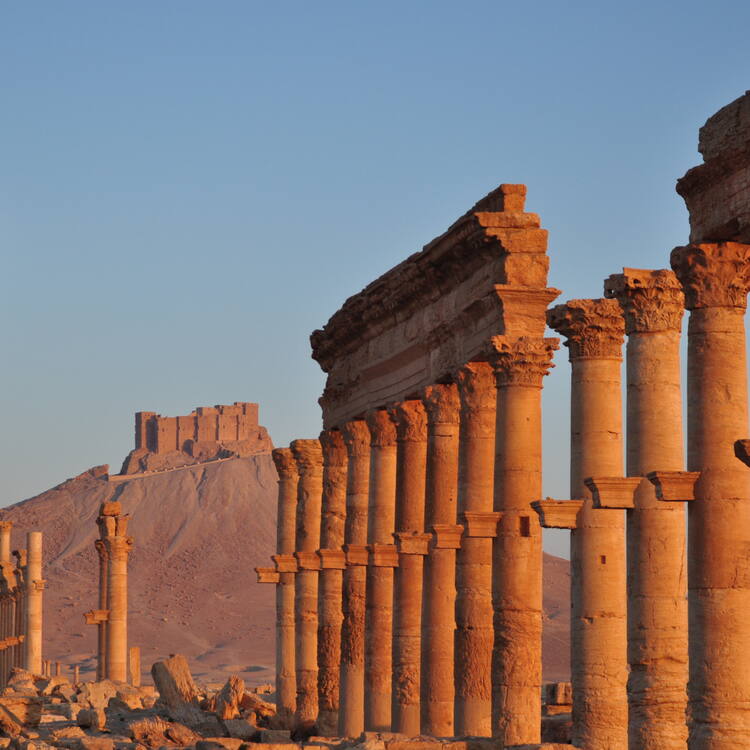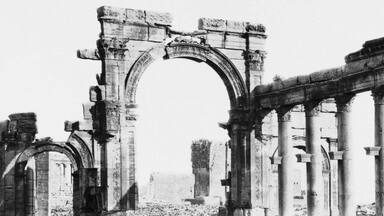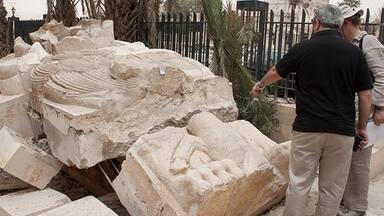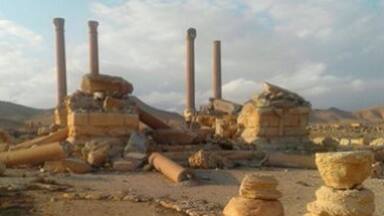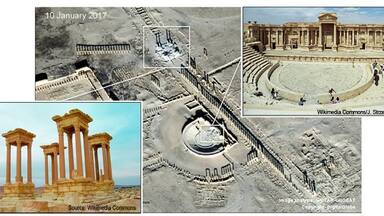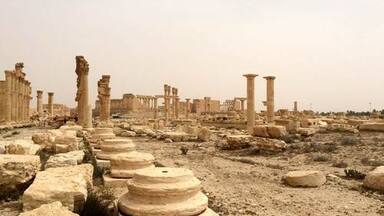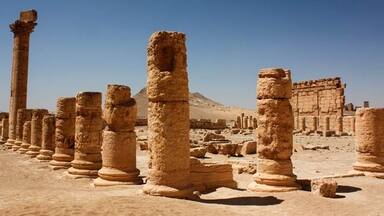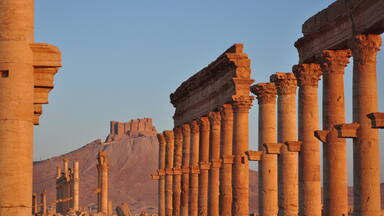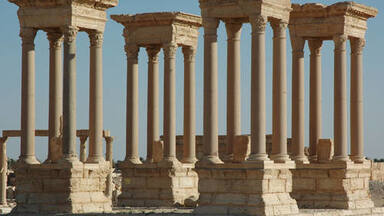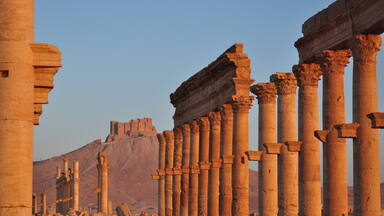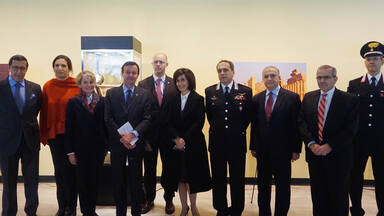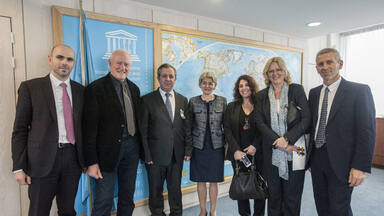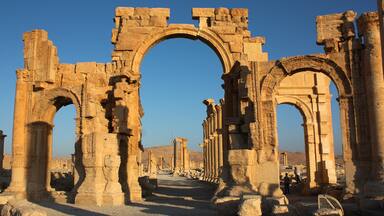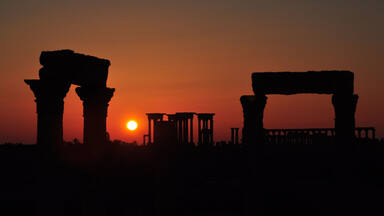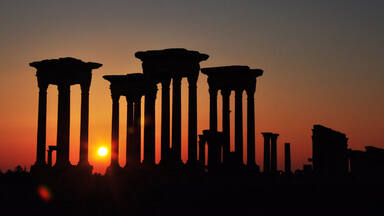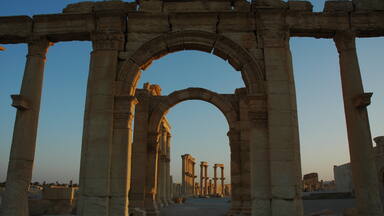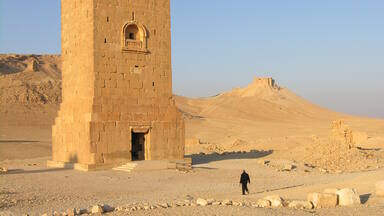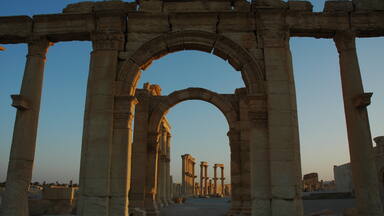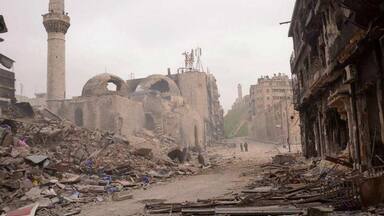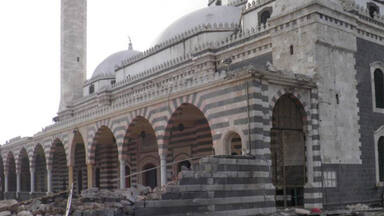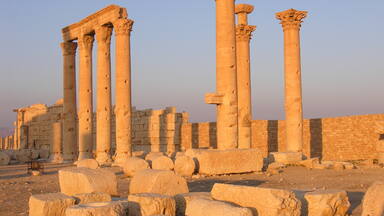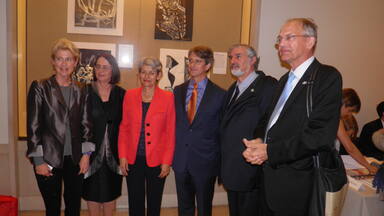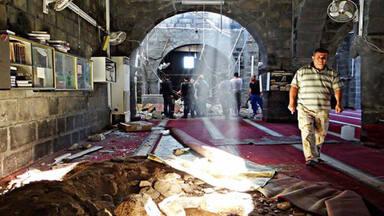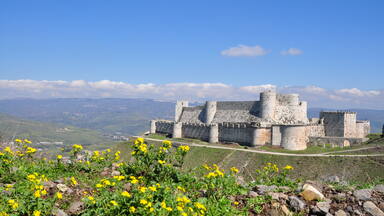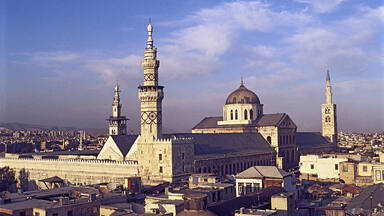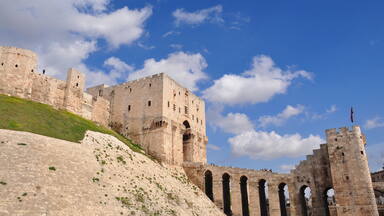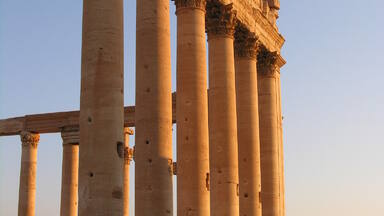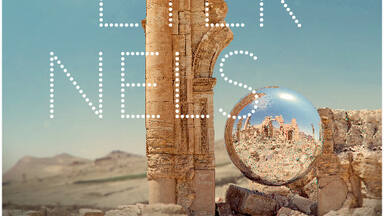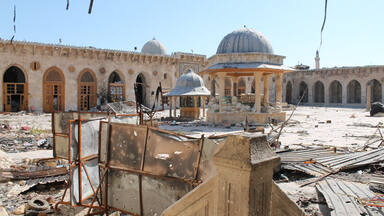Site of Palmyra
Site of Palmyra
An oasis in the Syrian desert, north-east of Damascus, Palmyra contains the monumental ruins of a great city that was one of the most important cultural centres of the ancient world. From the 1st to the 2nd century, the art and architecture of Palmyra, standing at the crossroads of several civilizations, married Graeco-Roman techniques with local traditions and Persian influences.
Description is available under license CC-BY-SA IGO 3.0
Site de Palmyre
Oasis du désert de Syrie au nord-est de Damas, Palmyre abrite les ruines monumentales d'une grande ville qui fut l'un des plus importants foyers culturels du monde antique. Au carrefour de plusieurs civilisations, l'art et l'architecture de Palmyre unirent aux Ier et IIe siècles les techniques gréco-romaines aux traditions locales et aux influences de la Perse.
Description is available under license CC-BY-SA IGO 3.0
موقع تدمر
تحتضن هذه الواحة الواقعة في الصحراء السورية شمال شرق دمشق آثاراً ضخمة لمدينة كبيرة شكلت أحد أهم المراكز الثقافية في العالم القديم. ونظراً لوقوعها عند ملتقى حضارات عدة، دمجت تدمر في فنها وهندستها طوال القرنين الاول والثاني بين التقنيات اليونانية الرومانية والتقاليد المحلية وتأثيرات بلاد فارس.
source: UNESCO/CPE
Description is available under license CC-BY-SA IGO 3.0
帕尔米拉古城遗址
帕尔米拉堪称叙利亚沙漠中的一片绿洲,它位于大马士革的东北方,是古代最重要的文化中心之一,城内现仍保存有当时的许多纪念性建筑。公元1世纪至2世纪,帕尔米拉处于几种文明的交汇处,所以其艺术和建筑能够将古希腊罗马的技艺与本地的传统及波斯的影响巧妙地融合在一起。
source: UNESCO/CPE
Description is available under license CC-BY-SA IGO 3.0
Археологические памятники Пальмиры
В этом оазисе, расположенном в Сирийской пустыне к северо-востоку от Дамаска, находятся монументальные руины большого города, который был одним из важнейших культурных центров древнего мира. В I-II вв. искусство и архитектура Пальмиры, находящейся в месте, где соприкасались несколько цивилизаций, сочетали в себе греко-римские приемы, местные традиции и персидские влияния.
source: UNESCO/CPE
Description is available under license CC-BY-SA IGO 3.0
Sitio de Palmira
Situado al nordeste de Damasco, en el desierto de Siria, el oasis de Palmira alberga las ruinas monumentales de una gran ciudad que fue uno de los centros culturales más importantes de la Antigüedad. Sometidas a la influencia de diversas civilizaciones, la arquitectura y las artes de Palmira fusionaron en los siglos I y II las técnicas grecorromanas con las tradiciones artísticas autóctonas y persas.
source: UNESCO/CPE
Description is available under license CC-BY-SA IGO 3.0
パルミラの遺跡
source: NFUAJ
Gebied van Palmyra
Source: unesco.nl
Outstanding Universal Value
Brief synthesis
An oasis in the Syrian desert, north-east of Damascus, Palmyra contains the monumental ruins of a great city that was one of the most important cultural centres of the ancient world. From the 1st to the 2nd century, the art and architecture of Palmyra, standing at the crossroads of several civilizations, married Graeco-Roman techniques with local traditions and Persian influences.
First mentioned in the archives of Mari in the 2nd millennium BC, Palmyra was an established caravan oasis when it came under Roman control in the mid-first century AD as part of the Roman province of Syria. It grew steadily in importance as a city on the trade route linking Persia, India and China with the Roman Empire, marking the crossroads of several civilisations in the ancient world. A grand, colonnaded street of 1100 metres' length forms the monumental axis of the city, which together with secondary colonnaded cross streets links the major public monuments including the Temple of Ba'al, Diocletian's Camp, the Agora, Theatre, other temples and urban quarters. Architectural ornament including unique examples of funerary sculpture unites the forms of Greco-roman art with indigenous elements and Persian influences in a strongly original style. Outside the city's walls are remains of a Roman aqueduct and immense necropolises.
Discovery of the ruined city by travellers in the 17th and 18th centuries resulted in its subsequent influence on architectural styles.
Criterion (i): The splendour of the ruins of Palmyra, rising out of the Syrian desert north-east of Damascus is testament to the unique aesthetic achievement of a wealthy caravan oasis intermittently under the rule of Rome from the Ier to the 3rd century AD. The grand colonnade constitutes a characteristic example of a type of structure which represents a major artistic development.
Criterion (ii): Recognition of the splendour of the ruins of Palmyra by travellers in the 17th and 18th centuries contributed greatly to the subsequent revival of classical architectural styles and urban design in the West.
Criterion (iv): The grand monumental colonnaded street, open in the centre with covered side passages, and subsidiary cross streets of similar design together with the major public buildings, form an outstanding illustration of architecture and urban layout at the peak of Rome's expansion in and engagement with the East. The great temple of Ba'al is considered one of the most important religious buildings of the 1st century AD in the East and of unique design. The carved sculptural treatment of the monumental archway through which the city is approached from the great temple is an outstanding example of Palmyrene art. The large scale funerary monuments outside the city walls in the area known as the Valley of the Tombs display distinctive decoration and construction methods.
Integrity (2009)
All the key attributes, including the main colonnaded street, major public buildings and funerary monuments, lie within the boundary. The tower tombs and the citadel are vulnerable to minor earthquakes and lack of conservation. Since the time of inscription, the population of the adjacent town has increased and is encroaching on the archaeological zone. Although traffic has increased, the main road that passed through the site has been diverted. Increased tourism has brought pressure for facilities within the property.
Authenticity (2009)
The key attributes display well their grandeur and splendour. However the setting is vulnerable to the encroachment of the adjacent town that could impact adversely on the way the ruins are perceived as an oasis closely related to their desert surroundings.
Protection and management requirements (2009)
The site was designated a national monument and is now protected by the National Antiquities law 222 as amended in 1999. A buffer zone was established in 2007 but has not yet been submitted to the World Heritage Committee.
The regional strategic action plan currently under preparation is expected to provide guidelines to expand and redefine the site as a cultural landscape, with respect to the transitional zones around the archaeological site, the oasis and the city.
There is an on-going need for a conservation and restoration plan to be developed that addresses fully the complex issues associated with this extensive multiple site and will allow for coordinated management, clear priorities and a cultural tourism strategy and address the issues of expansion of the nearby town.
